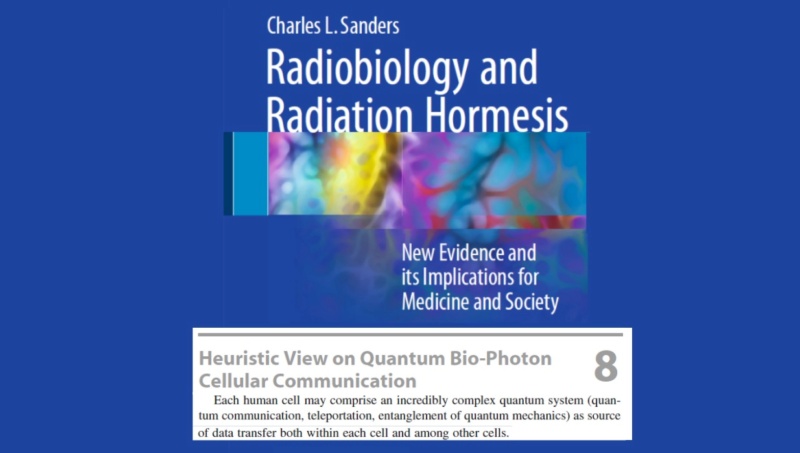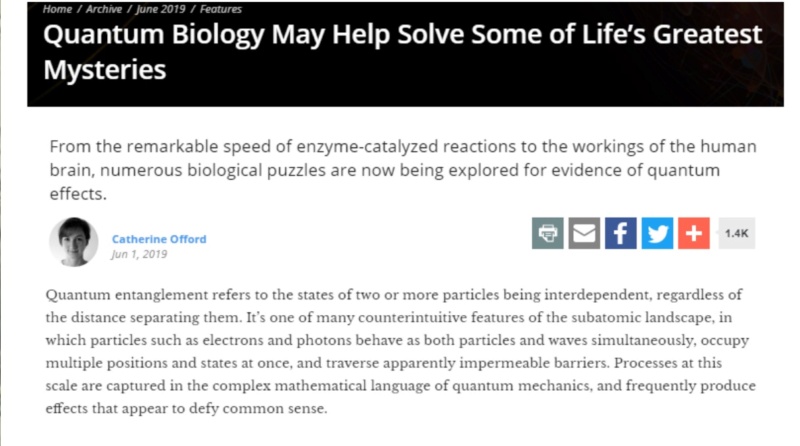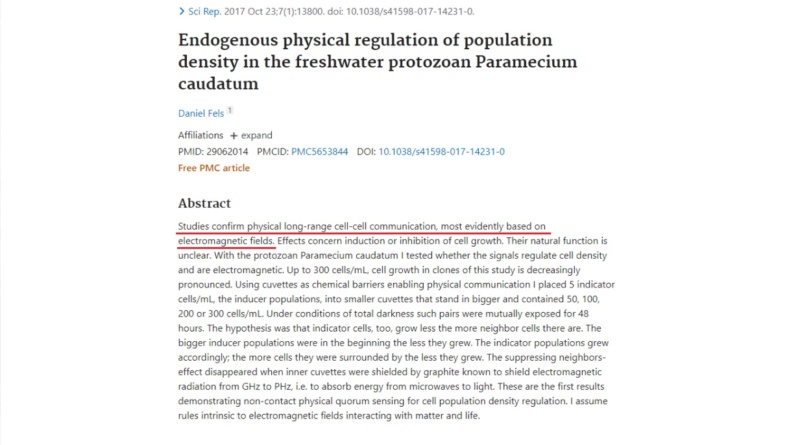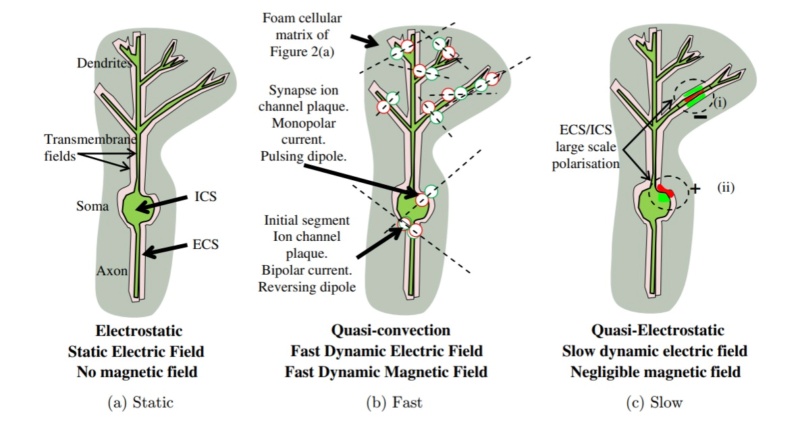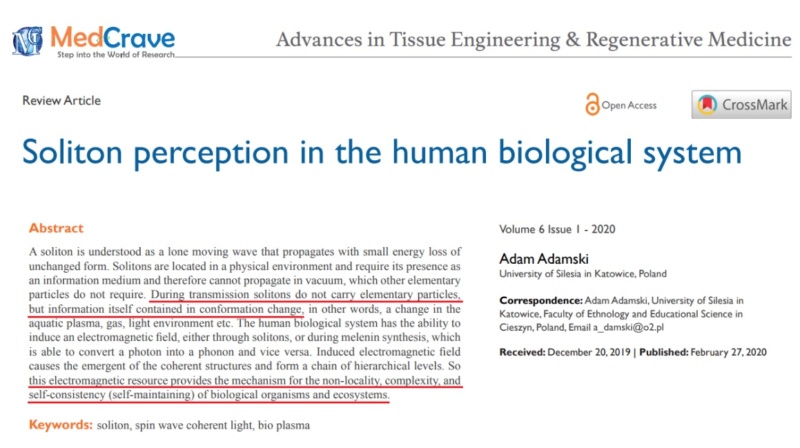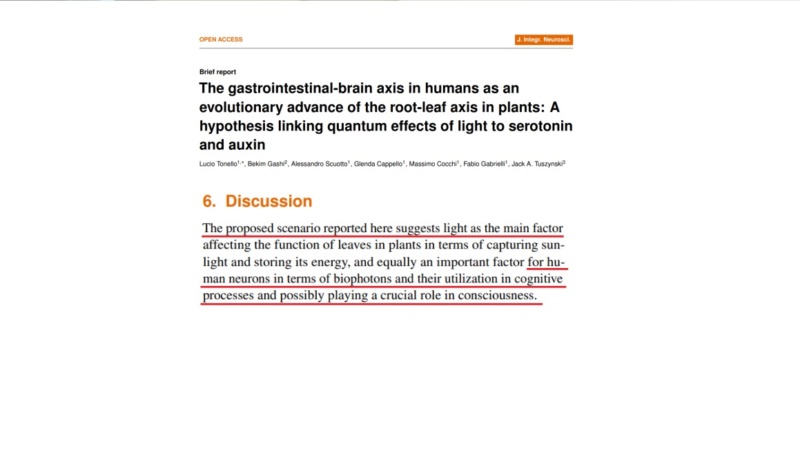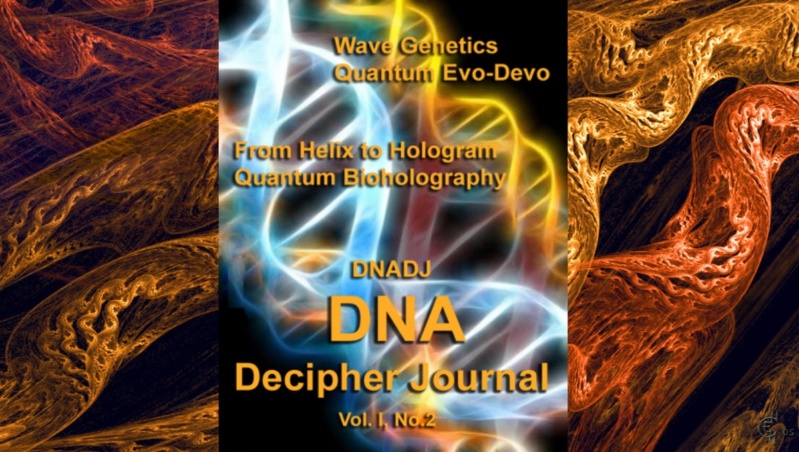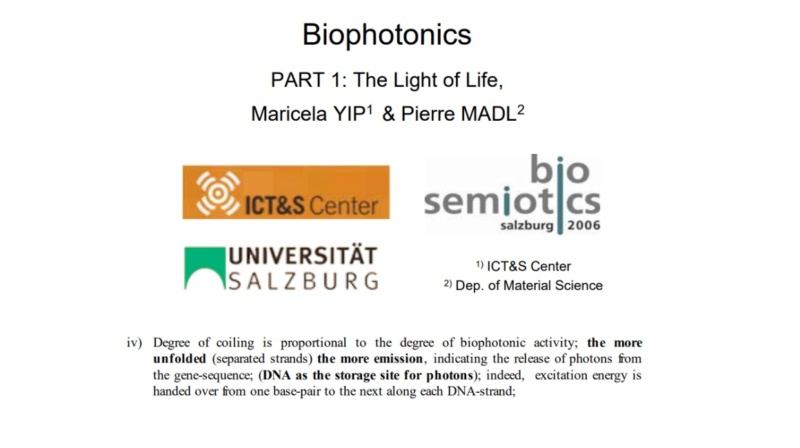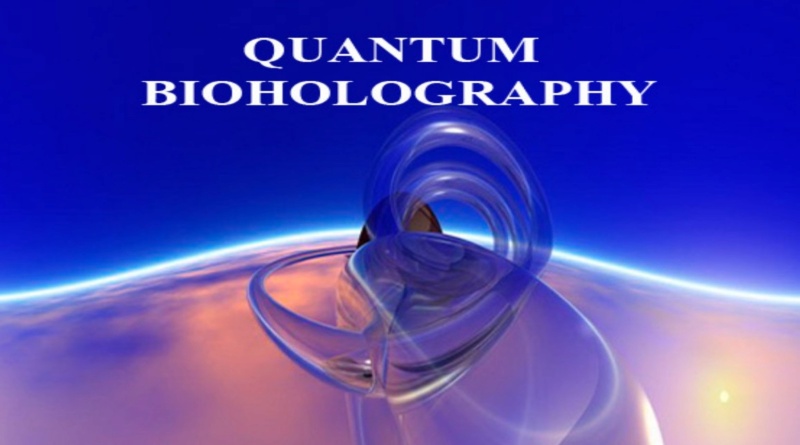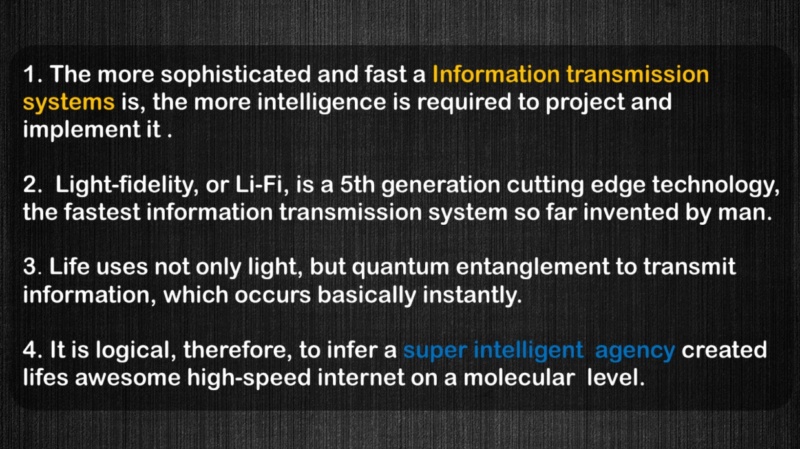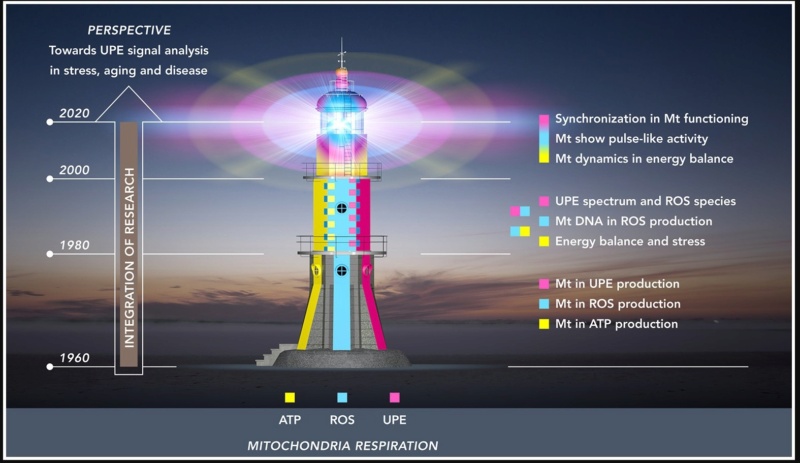The quantum world is beyond what we have ever imagined https://reasonandscience.catsboard.com/t3021-awe-inspiring-biophoton-cell-cell-communication-points-to-design#7999That entanglement can be maintained for a photon passing through brain tissue is, to put it mildly, unexpected under the materialistic assumptions of Darwinian evolution.
In showing why this is the case, first it is important to note that one of most formidable hurdles in building quantum computers is preventing a quantum system from decohering. That is to say, one of the most formidable hurdles in building a quantum computer is isolating photons from noise so as to prevent photons from becoming entangled with the environment rather than staying entangled with its original photon pair.
Information is Quantum – Charles Bennett – video
39:30 minute mark: “Entanglement is ubiquitous: Almost every interaction between two systems creates entanglement between them… Most systems in nature… interact so strongly with the environment as to become entangled with it almost immediately.”… 44:00 minute mark: “A classical communications channel is a quantum communication channel with an eavesdropper (maybe only the environment)… A classical computer is a quantum computer handicapped by having eavesdroppers on all its wires.”
https://uncommondescent.com/intelligent-design/philip-cunningham-offers-information-is-quantum/
Understanding quantum computers: The noise problem by TRISTAN GREENE — Oct 25, 2018
Excerpt: Quantum computers are fragile miracles of physics that are unreliable, cost-prohibitive, and more error-prone than a shortstop with no depth perception.,,,
To make them useful we have to make them reliable. And that’s a pretty tall order.
The problem, in a nutshell, is noise.
https://thenextweb.com/artificial-intelligence/2018/10/25/understanding-quantum-computers-the-noise-problem/
“it is remarkable: a photon, the smallest physical entity with quantum properties of which light consists, is interacting with a biological system consisting of billions of cells, all in a warm and wet environment,”,, and the researched added, “The response that the photon generates survives all the way to the level of our awareness despite the ubiquitous background noise. Any man-made detector would need to be cooled and isolated from noise to behave the same way.”,,, “What we want to know next is how does a biological system achieve such sensitivity? How does it achieve this in the presence of noise?”
Study suggests humans can detect even the smallest units of light – July 21, 2016
Excerpt: Research,, has shown that humans can detect the presence of a single photon, the smallest measurable unit of light. Previous studies had established that human subjects acclimated to the dark were capable only of reporting flashes of five to seven photons.,,,
it is remarkable: a photon, the smallest physical entity with quantum properties of which light consists, is interacting with a biological system consisting of billions of cells, all in a warm and wet environment,” says Vaziri. “The response that the photon generates survives all the way to the level of our awareness despite the ubiquitous background noise. Any man-made detector would need to be cooled and isolated from noise to behave the same way.”,,,
The gathered data from more than 30,000 trials demonstrated that humans can indeed detect a single photon incident on their eye with a probability significantly above chance.
“What we want to know next is how does a biological system achieve such sensitivity? How does it achieve this in the presence of noise?”
http://phys.org/news/2016-07-humans-smallest.html
Thus for a entangled photon to survive being passed through brain tissue without loosing its entanglement because of the noise that is presupposed, by Darwinists, to be present in biological systems is, (or should be), as surprising for Darwinists as if you jumped into a swimming pool, swam to the other side of the pool, got out and found, to your astonishment, that you were completely dry even though you just swam through an entire pool.
Darwinists, with their reductive materialistic framework, and their belief that life is dominated by “random thermodynamic jostling” at the molecular level, simply have no clue how quantum mechanical principles can be possible in biological systems.
As Jim Al-Khalili states, “”,, Physicists and Chemists have had a long time to try and get use to it (Quantum Mechanics). Biologists, on the other hand have got off lightly in my view. ,,,
at the molecular level living organisms have a certain order. A structure to them that’s very different from the random thermodynamic jostling of atoms and molecules in inanimate matter of the same complexity. In fact, living matter seems to behave in its order and its structure just like inanimate cooled down to near absolute zero. Where quantum effects play a very important role.”
Jim Al-Khalili – Quantum biology – videoJim Al-Khalili, at the 2:30 minute mark of the following video states,
“,, Physicists and Chemists have had a long time to try and get use to it (Quantum Mechanics). Biologists, on the other hand have got off lightly in my view. They are very happy with their balls and sticks models of molecules. The balls are the atoms. The sticks are the bonds between the atoms. And when they can’t build them physically in the lab nowadays they have very powerful computers that will simulate a huge molecule.,, It doesn’t really require much in the way of quantum mechanics in the way to explain it.”
At the 6:52 minute mark of the video, Jim Al-Khalili goes on to state:
“To paraphrase, (Erwin Schrödinger in his book “What Is Life”), he says at the molecular level living organisms have a certain order. A structure to them that’s very different from the random thermodynamic jostling of atoms and molecules in inanimate matter of the same complexity. In fact, living matter seems to behave in its order and its structure just like inanimate cooled down to near absolute zero. Where quantum effects play a very important role. There is something special about the structure, about the order, inside a living cell. So Schrodinger speculated that maybe quantum mechanics plays a role in life”.
https://www.youtube.com/watch?v=zOzCkeTPR3Q
“What happens is this classical information (of DNA) is embedded, sandwiched, into the quantum information (of DNA). And most likely this classical information is never accessed because it is inside all the quantum information. You can only access the quantum information or the electron clouds and the protons. So mathematically you can describe that as a quantum/classical state.”
Elisabeth Rieper – Classical and Quantum Information in DNA – video (Longitudinal Quantum Information resides along the entire length of DNA discussed at the 19:30 minute mark; at 24:00 minute mark Dr Rieper remarks that practically the whole DNA molecule can be viewed as quantum information with classical information embedded within it)
https://www.youtube.com/watch?v=2nqHOnVTxJE&feature=youtu.be&t=1176
Quantum Critical Proteins – Stuart Lindsay – Professor of Physics and Chemistry at Arizona State University – 2018
Excerpt: The difficulty with this proposal lies in its improbability. Only an infinitesimal density of random states exists near the critical point.,,
Gábor Vattay et al. recently examined a number of proteins and conducting and insulating polymers.14 The distribution for the insulators and conductors were as expected, but the functional proteins all fell on the quantum-critical distribution. Such a result cannot be a consequence of chance.,,,
WHAT OF quantum criticality? Vattay et al. carried out electronic structure calculations for the very large protein used in our work. They found that the distribution of energy-level spacings fell on exactly the quantum-critical distribution, implying that this protein is also quantum critical. There is no obvious evolutionary reason why a protein should evolve toward a quantum-critical state, and there is no chance at all that the state could occur randomly.,,,
https://inference-review.com/article/quantum-critical-proteins
As the following article states, “the possibility of finding even one (biomolecule) that is in the quantum critical state by accident is mind-bogglingly small and, to all intents and purposes, impossible.,, of the order of 10^-50 of possible small biomolecules and even less for proteins,”,,,
Quantum criticality in a wide range of important biomolecules – Mar. 6, 2015
Excerpt: “Most of the molecules taking part actively in biochemical processes are tuned exactly to the transition point and are critical conductors,” they say.
That’s a discovery that is as important as it is unexpected. “These findings suggest an entirely new and universal mechanism of conductance in biology very different from the one used in electrical circuits.”
The permutations of possible energy levels of biomolecules is huge so the possibility of finding even one (biomolecule) that is in the quantum critical state by accident is mind-bogglingly small and, to all intents and purposes, impossible.,, of the order of 10^-50 of possible small biomolecules and even less for proteins,”,,,
“what exactly is the advantage that criticality confers?”
https://medium.com/the-physics-arxiv-blog/the-origin-of-life-and-the-hidden-role-of-quantum-criticality-ca4707924552
The Puzzling Role Of Biophotons In The Brain – Dec. 17, 2010
Excerpt: It’s certainly true that electrical activity in the brain is synchronised over distances that cannot be easily explained. Electrical signals travel too slowly to do this job, so something else must be at work.,,,
,,, It’s a big jump to assume that photons do this job.
https://www.technologyreview.com/2010/12/17/198375/the-puzzling-role-of-biophotons-in-the-brain/
,,, zero time lag neuronal synchrony despite long conduction delays – 2008
Excerpt: Multielectrode recordings have revealed zero time lag synchronization among remote cerebral cortical areas. However, the axonal conduction delays among such distant regions can amount to several tens of milliseconds. It is still unclear which mechanism is giving rise to isochronous discharge of widely distributed neurons, despite such latencies,,,
Remarkably, synchrony of neuronal activity is not limited to short-range interactions within a cortical patch. Interareal synchronization across cortical regions including interhemispheric areas has been observed in several tasks (7, 9, 11–14).,,,
Beyond its functional relevance, the zero time lag synchrony among such distant neuronal ensembles must be established by mechanisms that are able to compensate for the delays involved in the neuronal communication.
Latencies in conducting nerve impulses down axonal processes can amount to delays of several tens of milliseconds between the generation of a spike in a presynaptic cell and the elicitation of a postsynaptic potential (16). The question is how, despite such temporal delays, the reciprocal interactions between two brain regions can lead to the associated neural populations to fire in unison (i.e. zero time lag).,,,
https://www.ncbi.nlm.nih.gov/pmc/articles/PMC2575223/
Long Range Entanglement in the Brain – video (1:55 minute mark)
https://www.youtube.com/watch?v=uo9CtOuogqA&feature=youtu.be&t=113
In fact, at about the 16:30 minute mark of the following video, an interesting experiment on the sleeping brain is highlighted in which it is demonstrated that there is a fairly profound difference in the way the brain ‘shares information’ between different parts of the brain in its sleeping state compared to how the brain ‘shares information’ with widely separated parts of the brain in its waking state. i.e. In the sleeping state, the brain shares much less information with widely separated parts of the brain than the brain does during our waking state.
Through The Wormhole s02e01 Is There Life After Death – video (16:30 minute mark)
https://www.youtube.com/watch?v=7XhrDrqmXE4
Of note, the preceding video, (after you sign up), can be watched in much better quality at this following site (season 2 episode 1)
https://www.sciencechannel.com/tv-shows/through-the-wormhole/
Researchers: Deep sleep short-circuits brain’s grid of connectivity – September 29, 2005
Excerpt: Tononi and his team observed the disconnect when brief, magnetically generated pulses of electricity were directed to specific regions of the brain. The pulses stimulated an electrochemical response from the targeted cells, which, when the subject was awake, rippled across the brain, traveling along networks of nerve fibers to different cerebral destinations. But when the subject was in deep sleep, the same response was quickly extinguished and did not travel beyond the stimulated cells.
When consciousness fades, according to Tononi, “the brain breaks down into little islands that can’t talk to one another.”
per news wisc.
And here is another article that backs up the claim that long range quantum coherence in the brain is at play when we are conscious compared to when we are asleep or unconscious,
Study targets ‘fingerprint’ of human consciousness – OCTOBER 11, 2019
Excerpt: “Remarkably, we saw very similar results in the two groups of participants scanned on opposite sides of the Atlantic. Specifically, loss of consciousness—whether due to propofol anaesthesia or brain injury—was accompanied by reduced functional diversity and integrative capacity in similar brain networks, which may represent a neurobiological marker or ‘brain fingerprint’ for consciousness,” Owen said.
Put simply, functional diversity and integrative capacity are properties of the brain that reveal how much information is being exchanged and integrated between different brain regions.
https://medicalxpress.com/news/2019-10-fingerprint-human-consciousness.html
Looking beyond space and time to cope with quantum theory – 29 October 2012
Excerpt: “Our result gives weight to the idea that quantum correlations somehow arise from outside spacetime, in the sense that no story in space and time can describe them,”
https://web.archive.org/web/20171011122351/http://www.quantumlah.org/highlight/121029_hidden_influences.php
Darwinists, with their reductive materialistic framework, simply have no beyond space and time cause that they can appeal so as to be able to explain the non-local quantum coherence and/or entanglement of the cell, (much less can they explain the ‘long range’ quantum coherence within the brain). Whereas Christians readily do have a beyond space and time cause that they can appeal to. As Colossians 1:17 states, “He is before all things, and in him all things hold together.”
Colossians 1:17
He is before all things, and in him all things hold together.
It is also important to realize that quantum information is conserved. As the following article states, In the classical world, information can be copied and deleted at will. In the quantum world, however, the conservation of quantum information means that information cannot be created nor destroyed.
Quantum no-hiding theorem experimentally confirmed for first time – 2011
Excerpt: In the classical world, information can be copied and deleted at will. In the quantum world, however, the conservation of quantum information means that information cannot be created nor destroyed. This concept stems from two fundamental theorems of quantum mechanics: the no-cloning theorem and the no-deleting theorem. A third and related theorem, called the no-hiding theorem, addresses information loss in the quantum world. According to the no-hiding theorem, if information is missing from one system (which may happen when the system interacts with the environment), then the information is simply residing somewhere else in the Universe; in other words, the missing information cannot be hidden in the correlations between a system and its environment.
https://phys.org/news/2011-03-quantum-no-hiding-theorem-experimentally.html
The implication of finding ‘non-local’, beyond space and time, and ‘conserved’, quantum information in molecular biology on such a massive scale, in every important biomolecule in our bodies, is fairly, and pleasantly, obvious.
That pleasant implication, of course, being the fact that we now have very strong empirical evidence suggesting that we do indeed have an eternal soul that is capable of living beyond the death of our material bodies. As Stuart Hameroff states in the following article, the quantum information,,, isn’t destroyed. It can’t be destroyed.,,, it’s possible that this quantum information can exist outside the body. Perhaps indefinitely as a soul.”
Leading Scientists Say Consciousness Cannot Die It Goes Back To The Universe – Oct. 19, 2017 – Spiritual
Excerpt: “Let’s say the heart stops beating. The blood stops flowing. The microtubules lose their quantum state. But the quantum information, which is in the microtubules, isn’t destroyed. It can’t be destroyed. It just distributes and dissipates to the universe at large. If a patient is resuscitated, revived, this quantum information can go back into the microtubules and the patient says, “I had a near death experience. I saw a white light. I saw a tunnel. I saw my dead relatives.,,” Now if they’re not revived and the patient dies, then it’s possible that this quantum information can exist outside the body. Perhaps indefinitely as a soul.”
– Stuart Hameroff – Quantum Entangled Consciousness – Life After Death – video (5:00 minute mark)
Mark 8:37
Is anything worth more than your soul?
Claim: “Jumping from quantum mechanics to “we are spiritual beings“ is a leap of faith.”
Reply: The Half-Truths of Materialist Evolution – DONALD DeMARCO – 02/06/2015
Excerpt: but I would like to direct attention to the unsupportable notion that the human brain, to focus on a single phenomenon, could possibly have evolved by sheer chance. One of the great stumbling blocks for Darwin and other chance evolutionists is explaining how a multitude of factors simultaneously coalesce to form a unified, functioning system. The human brain could not have evolved as a result of the addition of one factor at a time. Its unity and phantasmagorical complexity defies any explanation that relies on pure chance. It would be an underestimation of the first magnitude to say that today’s neurophysiologists know more about the structure and workings of the brain than did Darwin and his associates.
Scientists in the field of brain research now inform us that a single human brain contains more molecular-scale switches than all the computers, routers and Internet connections on the entire planet! According to Stephen Smith, a professor of molecular and cellular physiology at the Stanford University School of Medicine, the brain’s complexity is staggering, beyond anything his team of researchers had ever imagined, almost to the point of being beyond belief. In the cerebral cortex alone, each neuron has between 1,000 to 10,000 synapses that result, roughly, in a total of 125 trillion synapses, which is about how many stars fill 1,500 Milky Way galaxies!
A single synapse may contain 1,000 molecular-scale switches. A synapse, simply stated, is the place where a nerve impulse passes from one nerve cell to another.
Phantasmagorical as this level of unified complexity is, it places us merely at the doorway of the brain’s even deeper mind-boggling organization. Glial cells in the brain assist in neuron speed. These cells outnumber neurons 10 times over, with 860 billion cells. All of this activity is monitored by microglia cells that not only clean up damaged cells but also prune dendrites, forming part of the learning process. The cortex alone contains 100,000 miles of myelin-covered, insulated nerve fibers.
The process of mapping the brain would indeed be time-consuming. It would entail identifying every synaptic neuron. If it took a mere second to identify each neuron, it would require four billion years to complete the project.
https://www.ncregister.com/news/the-half-truths-of-materialist-evolution
The Human Brain Is ‘Beyond Belief’ by Jeffrey P. Tomkins, Ph.D. * – 2017
Excerpt: The human brain,, is an engineering marvel that evokes comments from researchers like “beyond anything they’d imagined, almost to the point of being beyond belief”1 and “a world we had never imagined.”2,,,
Perfect Optimization
The scientists found that at multiple hierarchical levels in the whole brain, nerve cell clusters (ganglion), and even at the individual cell level, the positioning of neural units achieved a goal that human engineers strive for but find difficult to achieve—the perfect minimizing of connection costs among all the system’s components.,,,
Vast Computational Power
Researchers discovered that a single synapse is like a computer’s microprocessor containing both memory-storage and information-processing features.,,, Just one synapse alone can contain about 1,000 molecular-scale microprocessor units acting in a quantum computing environment. An average healthy human brain contains some 200 billion nerve cells connected to one another through hundreds of trillions of synapses. To put this in perspective, one of the researchers revealed that the study’s results showed a single human brain has more information processing units than all the computers, routers, and Internet connections on Earth.1,,,
Phenomenal Processing Speed
the processing speed of the brain had been greatly underrated. In a new research study, scientists found the brain is 10 times more active than previously believed.6,7,,,
The large number of dendritic spikes also means the brain has more than 100 times the computational capabilities than was previously believed.,,,
Petabyte-Level Memory Capacity
Our new measurements of the brain’s memory capacity increase conservative estimates by a factor of 10 to at least a petabyte, in the same ballpark as the World Wide Web.9,,,
Optimal Energy Efficiency
Stanford scientist who is helping develop computer brains for robots calculated that a computer processor functioning with the computational capacity of the human brain would require at least 10 megawatts to operate properly. This is comparable to the output of a small hydroelectric power plant. As amazing as it may seem, the human brain requires only about 10 watts to function.11 ,,,
Multidimensional Processing
It is as if the brain reacts to a stimulus by building then razing a tower of multi-dimensional blocks, starting with rods (1D), then planks (2D), then cubes (3D), and then more complex geometries with 4D, 5D, etc. The progression of activity through the brain resembles a multi-dimensional sandcastle that materializes out of the sand and then disintegrates.13
He also said:
We found a world that we had never imagined. There are tens of millions of these objects even in a small speck of the brain, up through seven dimensions. In some networks, we even found structures with up to eleven dimensions.13,,,
Biophoton Brain Communication
Neurons contain many light-sensitive molecules such as porphyrin rings, flavinic, pyridinic rings, lipid chromophores, and aromatic amino acids. Even the mitochondria machines that produce energy inside cells contain several different light-responsive molecules called chromophores. This research suggests that light channeled by filamentous cellular structures called microtubules plays an important role in helping to coordinate activities in different regions of the brain.,,,
https://www.icr.org/article/10186



















